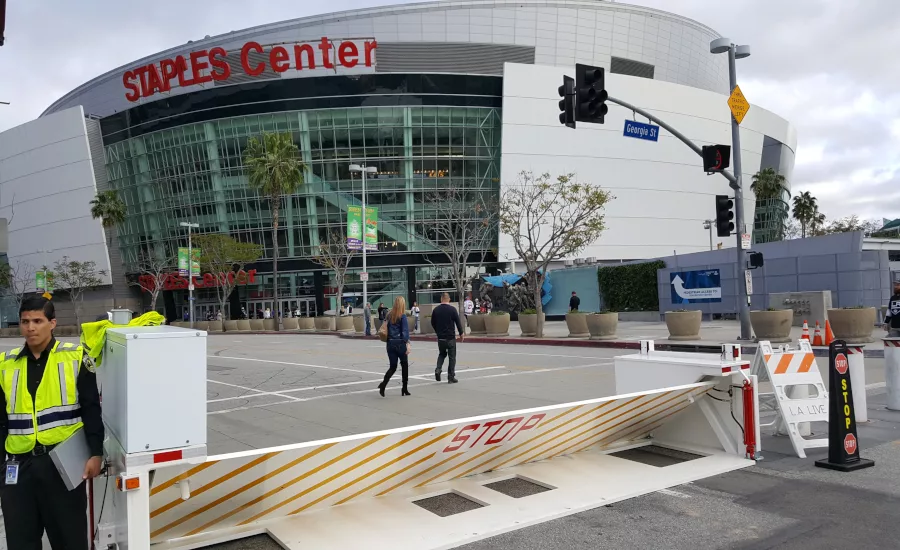Thwart Threats of Vehicle Terror Attacks

Recently, on April 23, 2018, a white rental van intentionally plowed down a crowd of pedestrians in the Toronto suburb of Richmond Hill, killing ten and injuring 15. On October 31, 2017, an Islamic terrorist drove a rented pickup truck into cyclists and runners for about one mile of a bike path in Lower Manhattan. The vehicle-ramming attack killed eight people and injured eleven others.
This has been happening for some time – vehicles being used as weapons. However, it was an intoxicated driver that injured at least 28 people when smashing into a Mardi Gras parade, at an unprotected New Orleans intersection on February 25, 2017. Terrorist or not, any type of driver can be dangerous to large crowds of people.
To stop such attacks, security professionals need to be cognizant of two different types of vehicle access points. The first is in a location where the primary use is pedestrian but, frequently, vehicles need to pass through. An example could be a square in which the maintenance truck comes through to clean the square periodically. Such access points are well served by bollards, some moveable that go up and down to let vehicles through and others fixed or stationary.
The other access points are those that are temporary. At a stadium, traffic may need rerouting for sporting weekends. The city is having a parade. In either case, sections normally open to traffic will be closed to create pedestrian paths and gathering points. However, these areas still have a need for delivery trucks and certain other authorized vehicles to enter. These locations are best protected with crash-rated portable barriers that erect in 15 minutes and are then removed once the event is over.
Bollards - the Most Used Permanent Solutions
Bollards are aesthetically pleasing and let pedestrians move between them in non-roadway applications. Bollard systems operate individually or in groups. Moveable bollards, which can go up and down, are used for intermediate level security applications. Buyers can specify ornamental steel trim attached directly to the bollard or select cast aluminum sleeves, which slip right over the crash tube.
Fixed post bollards are available to secure the sides of roadways with the same crash rating and appearance as their moveable cousins. Versus cement barriers such as posts and pots, many campuses prefer fixed post bollards for several reasons. When hit, cement posts and pots can explode, literally spreading shrapnel throughout the crowd, potentially creating numerous injuries. Shallow foundation bollards can be installed within sidewalks or on top of concrete deck truss bridges as well as conform to the inclines and turns of a locale.
Temporary Barriers Are Especially Popular
Staying one step ahead by identifying vulnerable areas, and securing them, is critical to staving off vehicular attacks. That means being able to deploy security equipment in tough conditions, at a moment's notice. Such equipment exists, portable temporary barriers.
Terrorists typically don't go where they see barricades, so placing them wherever possible attacks can happen reduces security risks dramatically. Temporary barriers are often used to protect facilities while permanent ones are being built. Plus, they've even been effective for the long-term where physical conditions preclude permanent solutions.
Their most common use, though, is for when vehicle access is required temporarily. Parking for the football game, a grand opening for the new facility and open houses are temporary events needing only a brief solution. These barriers can be deployed quickly and effectively, even in places where it's impossible to excavate for a permanent foundation.
Moveable self-contained barricades can be towed into position to control vehicle access within 15 minutes to answer the needs of organizations that quickly require a temporary barricade system to address a specific threat or secure a facility during special events. To move the barrier from that spot to another, the procedures are just reversed.
No Application Too Large or Small
Protecting people from vehicle attack is no small responsibility; it's becoming mandatory. Knowing that you've got the right equipment in place to secure the campus from vehicle threat and prevent what is becoming all too common human tragedy brings a peace of mind that no amount of money can buy. Carefully researching available options and consulting with experts will ultimately lead to the right solution in helping you protect your locale from vehicle-based terrorism.
Looking for a reprint of this article?
From high-res PDFs to custom plaques, order your copy today!







